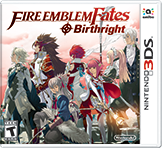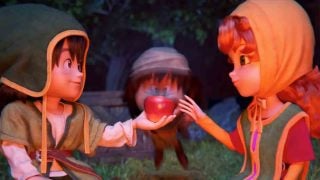Fire Emblem, one of Nintendo’s longest lived franchises, had never enjoyed the kind of success in America that it does in Japan. Sure, Marth and Roy finding their way into Super Smash Bros. Melee allowed for the games to gain enough traction to see their first localization in 2003, but even then they held more niche appeal and could never quite catch on. All of this changed with Fire Emblem Awakening, one of the 3DS’ finest. A revamped art style, more accessible gameplay, engaging and lovable (literally) characters, and a compelling story for them to thrive in; Awakening was a smash hit. Two weeks now I’ve been playing Fire Emblem Fates, the next in the series with the daunting task of living up to the expectations set by its predecessor. This review has taken some time, mostly because I could not stop myself from playing whenever I found a chance. Fire Emblem Fates absolutely stands as a worthy member of the series’ lineage, though not in the ways fans of Awakening may have hoped for.
For the sake of thoroughness, Fire Emblem Fates exists in three parts. Two of these parts, Birthright and Conquest, exist as full retail titles that can be purchased as cartridges or via the eShop. These storylines represent a critical choice presented early on in the game, forcing you as the focal character (Corrin, by default) to choose between two warring kingdoms. As child by birth of one and adoption from the other, the weight of this choice and the follow-through justify the multi-version approach.

The third, Revelation, only exists as a (soon-to-be-released) download with the exception of those who purchased the game’s sought after Special Edition. As it has not found its way into most hands and I’ve focused more on the two marquee versions, this review will not be discussing Revelation. The majority of my time, as well as all my first impressions, come from the Conquest storyline. I’ve also taken a brief look into Birthright, as I’ve spoken with others who’ve made it their default in order to gather a fuller picture of the gameplay differences.
The burden of those chosen by fate
While the choice between the more peacefully inclined, Eastern-inspired Hoshido and the European-esque, warmonger lead Nohr is the crux of the narrative, it also shapes what type of Fire Emblem game you’ll be playing for the foreseeable future. Fans of Awakening, or those who can claim it as their only Fire Emblem, may want to select Birthright, as the Hoshido-based journey is modeled most closely after its 3DS predecessor. This translates to opportunities to grind both gold and experience, as well as more gameplay as a whole due to world map-based skirmishes. While it is by no means lacking in either department, Birthright seemed to me a choice of quantity over quality.
Conquest instead plays more similar to classic Fire Emblem titles in that there is a finite amount of experience and gold in the main game, as well as different map objectives beyond routing the enemy or defeating bosses. This creates more tension across the entire experience, as decisions such as who you should promote to higher classes or who should fight at a given moment hold much more weight. I enjoy the prospect of this challenge, but I can recognize it isn’t for everyone. The varied difficulty options allow for some ease of access within both games, but no matter how you cut it Conquest will represent a greater difficulty.

Fates is unquestionably a Fire Emblem game, but the new elements it brings are numerous and welcome. These range from unique map elements, adjustments to existing elements, refinements to the time tested formula, and a whole new home base mechanic. The environments and characters of Nohr and Hoshido are distinct, feeling foreign from each other but right at home within the series. As an heir to royalty, you (as well as your siblings) are able to access unique points on the map called Dragon Veins to create drastic effects. These can range from a small area to heal within to completely altering the terrain, and knowing when and how to use them creates a unique wrinkle of strategy. Further into the game some of these were truly inspired and I only wish they were used more consistently, though that could have been at the risk of repetition. Certain maps are breathtaking to behold in general, both in the swath of enemies and the graphical flourishes. A particular Conquest chapter featured a ship, nothing new to Fire Emblem as a whole, but now its paddle wheels rotated and the waters clearly moved. These elements make for great set pieces even if they, at times, only amount to flavor rather than gameplay opportunities.
Taking up arms, together as one
The gameplay will feel familiar to fans of the series and of strategy RPGs in general. Maps are a series of turns: first you, then the enemy, then if present any third parties. A turn allows you to move units, attack, manage your inventory, more specialist actions tied to particular classes, and to pair up two units. You are only allowed one action per character (pending skills and other, specific instances) on a given turn, making every movement count. Thankfully, the touch screen is put to good use, providing ample information on any units highlighted, as well as more detailed descriptors with a quick tap. Map filters are also toggleable, showing where enemies could potentially reach and attack on their next turn. Once your turn is complete, all you can do is hope that your maneuvers were smart ones, as you are at the mercy of your enemies. While the AI isn’t perfect, without an understanding of the game and its elements as a whole your loyal units will die, usually the most vulnerable ones if you allow them to be. Learning how to cover your weaknesses, manipulate your enemies, and properly respond to anything unexpected is a hugely rewarding experience made all the more impactful by the cast of comrades you will be directing.

As mentioned, pairing up returns from Awakening allowing for your units to occupy a single space, providing stat boosts by default while removing a body from your army. The system has seen some changes from Awakening to make it more balanced, and I feel this is for the better. Instead of benefiting in both offense and defense by being paired, a pair of units cannot take advantage of followup attacks. Rather, the paired unit is both safe from damage and will defend the unit represented on the map once a meter is filled via attacking or being attacked. By having units side-by-side on the map but not paired, they are both viable targets for enemy attacks (barring smart placement) but are also able to attack one after the other for added damage. All of these actions also build support levels, the fan-favorite feature that provides entertaining and developing dialogue scenes for the characters while also allowing them to work better together whether paired up or just near each other on the map.
All of these come together in a great way and encouraged me to have frequent squads of characters near each other to continuously develop support levels while simultaneously covering each other’s weaknesses and emphasizing their strengths. Speaking of, the weapon triangle the series was known for has seen a bit of a change. Rather than the classic “swords beat axes beat lances beat swords” approach, all weapons are assigned a color: red, green, and blue. This extends to bows and other weapon types as well, making the advantages more impactful and the weaknesses more dire. Also gone is weapon durability, meaning weapons will not break after repeated use (with the exception of staves, which still have finite uses). Instead, higher tier weapons have other drawbacks to offset their higher stats. It comes down to you as a tactician to balance all of these and more factors to succeed in battle, as in Classic mode characters that fall in battle are truly dead.

Home is where the heart is
New to the series is the “My Castle” section. A natural evolution of Awakenings barracks and some of its world map elements, My Castle is a customizable base of operations with a variety of upgradable facilities. These are built and developed via Dragon Vein Points, a currency earned from completing maps and visiting other castles online. The network features are fairly straightforward and accessible, allowing anyone to select a name from their 3DS friends list and jump to their castle immediately. For those more interested in exploring blindly, you can browse popular castles from a menu, as well as generate a Castle Address (07034-02669-16967-67523) to share with others. By visiting others you can shop at their facilities, gather resources, or engage them in battle for a chance to either recruit them or inherit their developed skills. I’m surprised with how engaging My Castle has been, and I find myself checking it frequently. Even though I can visit a particular castle only once a day, checking in on my friends and gauging their progress (and helping myself to their goods) has become a ritual when I first load up the game.

Fates represents the first Fire Emblem title to feature amiibo support and thanks to the prominence of characters from the series in the most recent Super Smash Bros. there are currently four to use with potentially two more to come. Marth, Ike, Robin and Lucina are all compatible with the game and allow these characters to visit your castle to provide accessories, fun dialogue, and eventually a chance to face them in battle. Once bested they can be recruited to your army, though they lack supports and other features the core cast have. It’s still a great use of the figures, though sadly the host of other amiibo do not bring anything to the table. No word has been given if the upcoming Roy and Corrin amiibo will have similar features at this time, but if they did I imagine they would be the same as the others.

The weight of choices made
If it hasn’t been made clear yet, I absolutely love this series and find the game an enjoyable part of the lineage. What criticisms I hold for it are less on the game as a whole and more in relation to its immediate predecessor. Awakening was a resurgence for the series and following up on that success was going to be difficult. While the sales and popularity of Fates is at an all-time high for the series, I personally feel its new additions are more side steps than progressions. The game is enjoyable, the characters likable, and features fully fleshed. But they do not push the boundaries of the series in any one way, with the possible exception of My Castle and its network features. What we have is a refined, trimmed game that in splitting its narrative has lost some cohesion. The cast is massive and delightful, but at this time most people are gated from seeing all of them together. Revelation will be taking steps to rectify this, but as-is it’s an unfortunate reality.
The split of the games might make the narrative more robust when seen as a whole, but by knowing I’m essentially missing out on half or more of a story at a given time I felt somewhat robbed. Even in Conquest, where the choices matter even more, I couldn’t stop myself from wondering what Birthright had to offer instead. Despite the original Japanese title of the game, I shouldn’t be wondering “what if…” constantly. Granted, I still have not completed the entirety of what Fates has to offer, and this could all change once I’ve experienced the full story and all its different paths.

With some of the localization choices having fans up in arms, I felt it necessary to briefly address those. First, the script is fantastic and may actually be one area where Fates unquestionably bests Awakening. The localization team has truly outdone itself, though how enjoyable supports will be depends on the characters themselves, for which I felt Awakening had a more gripping cast (at least so far). The American voices are more than serviceable, with what limited voiced dialogue there is, though this is a game where dual audio should be a considered option. The removal of features, specifically the ability to ‘touch’ other characters has not made me enjoy the game any less and the rewards from such actions are still present. That said, with how some of the characters act and look, as well as the ability to frequent a hot spring for some sometimes steamy moments, I have to wonder why the feature was almost completely removed. The inclusion of same-sex marriage options is a progressive step for Nintendo, but more variety in the area would have been appreciated.

Strategic reflections, to fight another day
From a gameplay standpoint, I do feel Conquest is the superior version due to the unique map requirements. Where Birthright focuses mostly on a simple fight to the finish again and again, Conquest may have me defending areas for a number of turns, trying to talk to NPCs, or even a choice of multiple finish conditions. That said, even compared to the older Fire Emblem titles it takes inspiration from, Conquest is a very difficult game by most standards and at times this creates the kind of frustrations that can be hand waved by human error or misjudged spacing. While the presence of DLC provides an opportunity to grind even in Conquest, I feel compelled to face its challenge as the game was designed. Whether this is stubbornness or dedication on my part is still up in the air, but even with frequent restarts I don’t feel discouraged from trying again and again. Of course, a lot of this is subjective, and with more time spent with Birthright I might be singing a different tune.
I will never claim to be spectacular at Fire Emblem, nor do I go out of my way to optimize my units. That said I’ve been playing them since they’ve come to America and those experiences have served me well in my choice of Conquest. I’m thoroughly enjoying the game in spite of any negative points I bring up, and as stated, I found it difficult to put down to even compile all these thoughts. I’ve grown to depend on my Nohrian units and I’m absolutely looking forward to what Birthright has to offer. Learning more about the characters I’ve faced in battle so far is a nice hook, though it’ll be difficult to face those I’ve grown accustomed to.
For anyone owning a 3DS, I highly recommend picking up either version of the game, with Birthright as a suggested entry point. No matter which side you choose, you are granting yourself a chance at a worthy followup to Awakening that may not be perfect or as refreshing, but makes up for that by how solidly put-together the entire package is. Just be prepared to live with your choices, no matter what.
Order your copy of Birthright or Conquest on Amazon today!
Leave a Comment
System Nintendo 3DS
Release Date Feb 19, 2016
No. of Players 1 player
Category Strategy, Role-Playing
PublisherNintendo
DeveloperIntelligent Systems

